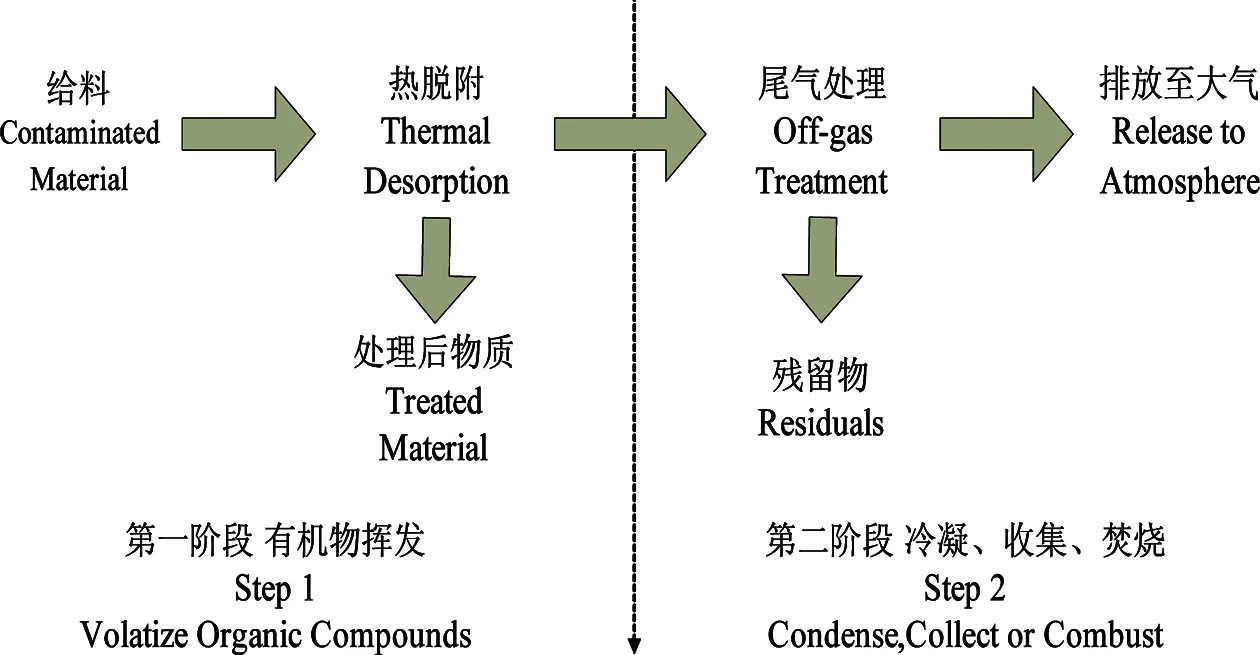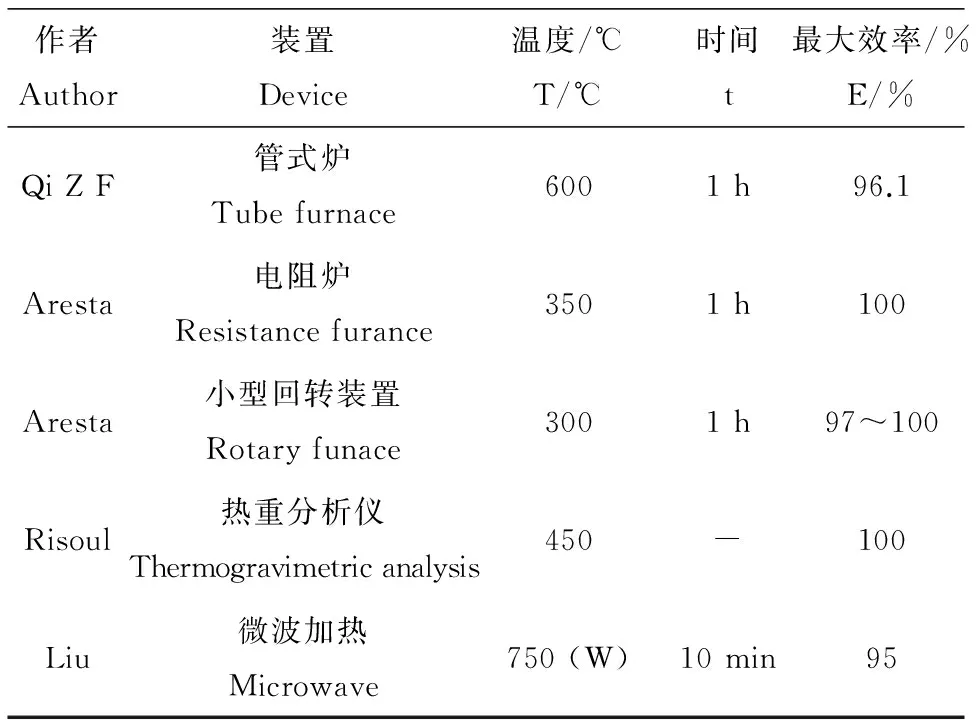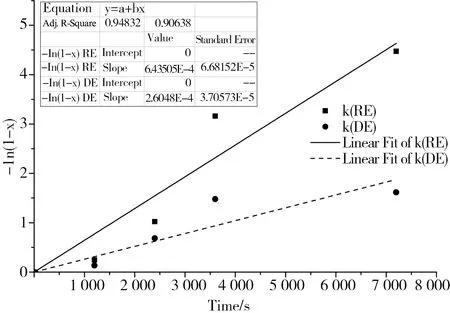多氯联苯污染土壤热脱附研究综述
赵中华,李晓东,陈彤,刘洁,倪明江
浙江大学热能工程研究所 能源清洁利用国家重点实验室,杭州 310027
多氯联苯污染土壤热脱附研究综述
赵中华,李晓东,陈彤,刘洁,倪明江
浙江大学热能工程研究所 能源清洁利用国家重点实验室,杭州 310027
综述了近年来国内外热脱附技术在修复多氯联苯(polychlorinated biphenyls, PCBs)污染土壤方面的研究进展。温度和停留时间是影响其脱附效率的最主要因素,另外脱附效果还受土壤性质以及载气、压力等其他因素的影响。氧气存在的条件下,脱附过程中会有呋喃(polychlorinated dibenzofurans, PCDFs)生成,导致整体毒性当量增加。PCBs的物理蒸发是其主要的脱附机制,同时伴随着脱氯和降解。协同热脱附通过添加改性剂,有效促进了PCBs的去除以及降解。冷凝,除尘,吸附一系列尾气处理用来降低尾气中PCBs的含量。文章最后给出了当前国内外的应用情况以及存在问题和今后的发展方向。
PCBs;热脱附;土壤修复;物理蒸发;毒性当量
多氯联苯(polychlorinated biphenyls, PCBs)又称氯化联苯,是持久性有机污染物(POPs)的一种,其结构式如图1所示。根据氯原子取代的数目以及位置不同,共有209种异构体,其中12种共平面的PCBs具有类似二噁英的毒性,被称为类二噁英多氯联苯(dioxin-like PCBs, dl-PCBs)[1]。为评价PCBs对健康影响的潜在效应,也可以通过毒性当量的概念以及毒性当量因子(toxic equivalency factor, TEF)来折算。许多学者和国际组织对PCBs的毒性当量因子做出研究及规定[2-3],其中当前最为被接受及应用的是2015年世界卫生组织定义的毒性当量因子[4],如表1所示。
PCBs由于其良好的电绝缘性和耐热性,在20世纪30年代到80年代被广泛的用于绝缘油、液压油以及涂料橡胶等的生产中[5]。但是,PCBs属于致癌物质,物理化学性质稳定、不易分解,不与酸、碱、氧化剂等物质发生反应,极难溶于水,由于其对脂肪具有很强的亲和力,很容易在脂肪中积累,损害皮肤和肝脏,引起中毒[6]。PCBs对生物毒性急性毒性不明显,一般更多的表现为对生物的亚急性和慢性毒害作用。现在研究表明PCBs可影响到生物体诸如免疫功能、激素代谢、生殖遗传等各个方面[7]。1968年日本曾因此发生的米糠油事件,1979年中国台湾也发生了类似的事件。PCBs在环境样品中广泛分布,由于PCBs低的挥发性和高的辛醇/水分配系数,所以它在大气和水中的含量较低[8]。由于土壤和沉积物的吸附、屏蔽等作用,PCBs一旦进入土壤等介质将会长期存留,并且对土栖生物也会产生潜在危害[9]。据估计,全球累计生产和应用的PCBs约为150万吨,其中约有1/4~1/3进入环境,对人类造成危害[10]。

图1 PCBs分子结构图Fig. 1 Molecular structure of PCBs

表1 12种dl-PCBs的分子式及WHO-TEF
修复PCBs污染土壤的技术主要分为物理修复、化学修复和生物修复3类[11]以及基于以上技术的联合修复技术[12]。其中热脱附技术被认为最有效的方法之一,热脱附[13-14](热解析)技术是通过直接或间接加热的方式,将土壤中的有机污染组分加热至足够高的温度,使其挥发成气态并与土壤分离的过程,挥发出的污染物被收集或者直接焚烧裂解。热脱附技术包含两个基本过程:第一阶段,加热待处理物质,将目标污染物挥发成气态分离;第二阶段,将含有污染物的尾气进行冷凝、收集以及焚烧等处理至标准之后排放至大气中[15]。研究表明,热脱附技术对PCDD/Fs、PCBs、PAHs、杀虫剂、石油等挥发性半挥发性有机污染物以及汞污染土壤有较好的修复效果[16-20]。相比于其他污染土壤修复技术,热脱附技术具有污染物处理范围宽、处理速率高、修复后土壤可再利用等优点[21]。特别是对于PCBs这类含氯有机污染物低温热脱附能够显著降低二噁英的生成[22]。

图2 热脱附基本过程图Fig. 2 Basic process of thermal desorption
1 热脱附技术主要影响因素(Main factors)
温度与停留时间是影响热脱附效率的最主要因素,停留时间对脱附效率的影响取决于温度。加热温度越高,停留时间越长,土壤中PCBs残余含量越小,脱附效率也就越高。
祁志福等[23]在一水平管式炉内进行了加热温度对PCBs污染土壤的热脱附过程影响的实验研究。结果发现温度显著影响PCBs的脱附效率,600 ℃时,脱附时间1 h,土壤中PCBs浓度由最初的524 μg·g-1降到20.4 μg·g-1,PCBs脱附效率达到96.1%。而300 ℃时,PCBs的脱附效率仅为64.2%。Aresta等[24]发现加热时间对脱附效果的影响取决于温度,温度较低时,需要较长的脱附时间来保证PCBs的脱附效率,350 ℃时,脱附60 min后污染土壤中的PCBs就会完全脱除。在热重分析仪中,Risoul等[25]发现当温度达到450 ℃时,几种类型的土壤中HCB的脱附效率都接近100%。微波加热是近些年新兴起的一种加热方式[26-28]。Liu等[29]采用微波加热方式对一绝缘油严重污染的土壤进行了脱附,微波功率设为750 W,脱附时间10 min,当分别添加2 g次磷酸钠和铁粉时,PCBs脱附效率可达80%;当活性炭、次磷酸钠和铁粉同时加入时,PCBs可以达到95%以上的脱附效率。
比较几位学者的研究成果,虽然反应装置及加热方式不一样,但是通过调节温度(功率)及时间都可以达到95%以上的脱附效率,进一步证明热脱附技术可以高效的修复PCBs污染土壤。分析导致最大脱附效率以及最佳温度不同的原因,其他一些因素,如土壤种类、土壤粒径、土壤中污染物的初始浓度、土壤的含水率、载气流量、载气的种类、升温速率以及气氛含氧量,都对热脱附过程会产生一定的影响。

表2 热脱附修复PCBs污染土壤效果
白四红等[30]研究发现载气流量的增大对PCBs的去除效率影响不显著,载气流量从100 mL·min-1增加到6倍(600 mL·min-1),土壤中残留PCBs略有降低,PCBs脱附效率从93.6%增加到95.2%;升温速率越大则PCBs的脱附效果越好,根据实验升温时间计算得到的PCBs含量变化速率与升温速率之间有明显的正线性相关性。土壤中的晶间水层对于PCBs的脱附有明显的抑制作用。随着温度的升高,表面粘附系数减小,抑制作用随之减弱[31]。细颗粒表面积比较大,可提供更多用于PCBs降解的表面,同时加热较快。所以相同温度及加热条件下,细颗粒较之粗颗粒有着更大的脱附效率以及降解效率[23]。Risoul等[32]通过对PCBs污染土壤热脱附的研究,发现PCBs的去除同时受压力、载气流量、土壤质量、初始污染物浓度的影响。Misaka等[33]在真空条件下对飞灰中的PCDD/Fs以及dl-PCBs进行了热脱附,377 ℃处理4 h,毒性当量降低了99.98%。
2 PCBs脱附机理(Desorption mechanism)
热脱附技术作为一种物理修复,PCBs的物理蒸发是其主要的脱附机制,较高氯代PCBs,低氯代PCBs由于其沸点低相同温度下更容易从污染土壤中脱附。只有在质子供体存在条件下,PCBs才会发生脱氯反应[34],另外,PCBs发生降解反应时,也会受到PCBs氯原子数目以及取代位置的影响[35]。Weber等[36]研究发现飞灰中D10CB在340 ℃时就开始发生脱氯,主要发生在与毒性相关的3、4位置,在380 ℃下处理1 h,D10CB基本上可以完全分解。祁志福[37]在研究中也发现随着温度的增加,土壤中残留PCBs以及气相中PCBs低氯代的PCBs同系物所占比重逐渐增加而高氯代PCBs同系物比重减少。热脱附过程PCBs的脱附行为可用一级反应动力学方程进行良好的拟合。
但在有氧条件下,PCBs作为前驱物[38]会产生大量的PCDFs,导致烟气中PCDFs含量显著增加,整体毒性当量也随之大幅增加。O2的存在对于PCBs的去除以及降解效率影响不大,但是气相以及固相中的PCDD/Fs含量与载气中的O2含量呈明显的正相关[39]。Sato等[40]在管式炉内,发现对于PCBs污染土壤,虽然热脱附后PCBs降解效率可达48%~70%,但是由于PCDD/Fs的生成,毒性当量反而是原始土壤毒性当量的2.8~6.3倍(固相)以及8.0~10.5倍(气相);沉淀物中PCBs添加量为20 mg·kg-1时,脱附前污染沉淀物总的毒性当量为160 pg-TEQ·g-1,脱附后沉淀物中毒性当量增加到840 pg-TEQ·g-1,尾气中毒性当量为160 pg-TEQ·g-1。Weber等[41]在150 ℃以及200 ℃也发现PCDFs大量的生成,热处理30 min,150 ℃时毒性当量增加144%,200 ℃毒性当量增加165%。Zhao等[42]通过13C-PCBs进一步验证了PCDFs形成的3种方式:ortho-Cl2脱除,HCl脱除(涉及2,3-氯原子的转移)以及ortho-H2的脱除。以PCB 77为例,PCDFs具体的生成过程如图4所示。

图3 PCBs脱附及降解过程速率常数拟合[37]Fig. 3 Rate constants fitting of PCBs desorption and degradation process[37]

图4 PCDFs由PCB 77生成路径[42]Fig. 4 Generation way from PCB 77 to PCDFs [42]
3 催化协同脱附(Synergetic desorption)
热脱附过程中,一方面要保证足够高的脱附及降解效率,另一方面,应尽可能的减少脱附过程的能量消耗,降低成本。恰当的协同处理可以促进PCBs的脱附以及降解过程,早有学者针对纳米铁在水中降解PCBs进行了研究[43-45]。其主要降解机理如下[46]:
2Fe0→2Fe2++4e-
3H2O→3H++3OH-
2H++2e-→H2(g)
RCl+H++2e-→RH+Cl-
催化剂的存在可以降低温度,使PCBs可以在低温条件下发生降解。刘洁等[47]研究了添加零价纳米铁对PCBs热脱附效果的影响,PCBs的脱附效果有显著的提高,而且低温条件下效果更明显。400 ℃时,2 g土壤中加入200 mg nZVI,PCBs去除效率可达94.2%;600 ℃时,脱附时间1 h,添加100 mg nZVI的污染土壤PCBs去除效率可达98.35%,而相同条件下没有添加nZVI的土壤PCBs去除效率为97.4%。另外,nZVI的存在还显著降低PCBs的毒性当量。常温常压下,Pd/Fe双金属催化剂的加入对PCBs的降解也有显著的影响,He等[48]发现Pd/Fe双金属添加量为0.5 g·g-1时,10 d后土壤中PCBs的去除效率可达到48.2%,并且去除效率随着催化剂添加量的增加以及修复时间的增长而提高。当PCBs初始浓度为5 mg·g-1,土壤pH为5.5时,PCBs去除效率最高可以达到73.8%。由于V2O5/WO3负载钛催化剂的加入,Weber等[41]发现在150~300 ℃的温度范围内,PCBs的脱附效率都达到了98%。
碱催化降解对于修复PCBs污染土壤也是一个可行的选择,它是一个催化脱氯加氢的过程[49]。碱催化降解过程中,PCBs经过2~3 h后可以实现99.99%的降解效率,并且没有PCDD/Fs的生成[50-51]。Weber等[36]对于有无喷射Ca(OH)2的两种飞灰在微反应器内进行了热脱附实验研究,发现喷射Ca(OH)2的飞灰中OCDD、OCDF以及D10CB在260 ℃就会发生加氢脱氯,比没有Ca(OH)2的飞灰低了80 ℃。刘洁等[52]发现NaOH的加入会促进污染土壤中PCBs的脱附和降解,特别是低温条件下促进作用更明显,协同热脱附作用显著。CuCl2的加入对PCBs有较好的脱氯作用,但在低温条件下容易生成PCDFs[53]。此外,碱催化降解对于PCDD/Fs、氯苯等其他一些有机污染物的降解也有很好的效果[54-55]。
4 含PCBs尾气控制技术(Off-gas treatment technology)
尾气的处理是一个比较复杂的过程,而且当前对于尾气中PCBs控制的研究较少,如果处理不当,会造成新的污染。静电除尘器、活性炭吸附以及湿式洗涤器等技术都可以通过尾气中污染物的聚集、吸附或者转移用于PCDD/Fs和PCBs污染气体的控制。通过催化加氢降解等技术可以彻底除去PCDD/Fs和PCBs。热脱附尾气处理通常包括冷凝、除尘、吸附等过程。脱附尾气首先经过冷凝装置,气态PCBs凝结后分离;然后经过除尘器除去烟气中的粉尘,最后经过活性炭吸附器对于尾气中的PCBs进行进一步的吸附。整个尾气系统在工作过程中保持一种微负压状态,以免含PCBs气体泄漏对环境造成二次污染[56]。脱附过程中像尿素、硫酸铵等抑制剂的加入也可以有效阻止PCBs和PCDD/Fs的生成[57-59]。
祁志福等[24]开发了一套含PCBs和粉尘的高温尾气多段式处理工艺流程,主要包括旋风除尘器、两级喷淋洗涤塔和活性炭吸附器。旋风除尘器对于烟气中PCBs的去除具有一定的效果。高温条件下,旋风除尘器的存在可降低烟气中30.2%~46.1%左右的毒性当量。湿式洗涤器对于烟气中PCBs和PCDD/Fs有良好的去除效果,两级喷淋可实现86.2%~97.8%的烟气PCBs毒性当量去除效率以及82.7%~95.0%的PCDD/Fs毒性当量去除效率。活性炭可有效吸附烟气中PCBs,吸附效率可达99.8%以上。Aresta等[24]通过铅、铑催化剂对脱附后的PCBs氢化处理、可以将PCBs转化为低氯或者无害有机物,5 h可以达到63%的转化效率,12 h转化效率为100%。
5 实际工程应用(Engineering application)
热脱附技术工艺流程如图5所示(出自北京建工环境修复股份有限公司工程案例)。实际应用过程中,为了提高整个系统的效率,应对PCBs污染土壤进行粉碎以及干化等预处理以控制土壤的粒径以及湿度。干化温度和搅拌速率的提高均有助于加速干化速率,而水分的内部扩散是PCBs污染土壤干化速率的主要影响因素[60]。

图5 热脱附技术工艺流程Fig. 5 Technical process of thermal desorption
据美国EPA最新发布的《超基金场地修复报告(第14版)》,在1982~2011年共有72个美国超级基金项目采用异位热脱附作为主要的修复技术[61]。而我国对异位热脱附技术的应用处于起步阶段,已有少量应用案例如表3所示。当前国外对于中小型场地处理成本约为100~300 美元·m-3,对于大型场地处理成本约为50 美元·m-3;国内处理成本约为600~2 000元·t-1。土壤质地、含水率以及污染物的种类都会对处理成本产生一定的影响。对于热脱附技术的成本做过调查:发现水分含量、污染物种类、污染物浓度以及处理量是影响成本的最主要因素。土壤修复成本调查研究结果显示对于土壤水分含量20%,石油浓度1 000 mg·L-1,成本随着处理量的增大而减小[62]。
6 存在问题及展望(Problems and prospects)
目前欧美国家已将土壤热脱附技术工程化,广泛应用于处理挥发性、半挥发性有机物和汞污染土壤、污泥等场地的修复。而我国热脱附修复污染场地研究尚处于起步阶段,目前主要设备均依赖进口,诸如相关设备投资成本过高、运行费用昂贵等问题尚未得到很好解决;由于对不同质地土壤,不同污染物的认识不够,导致其他二次污染物的产生;高粘土含量或湿度会增加处理费用,且高腐蚀性的进料会损坏处理单元[63];而且污染场地修复工程的实施过程当中还会产生噪音和扬尘、粉尘污染等环境影响,成为一个新的污染源。上述问题需要国内产学研团队加强多学科交叉融合,团结协作以共同解决。发展不同污染类型土壤的前处理和脱附废气处理等技术,优化工艺并研发相关的自动化成套设备正是共同努力的方向[22]。

表3 国内异位热脱附技术应用案例
[1] 刘静, 崔兆杰, 许宏宇. 土壤和沉积物中多氯联苯(PCBs)的环境行为研究进展[J]. 山东大学学报: 工学版, 2006, 36(5): 94-98
Liu J, Cui Z J, Xu H Y. The review of the environmental behaviors of polychlorinated biphenyls (PCBs) in soils and sediments [J]. Journal of Shandong University: Engineering Science, 2006, 36(5): 94-98 (in Chinese)
[2] Ahlborg U G, Becking G C, Birnbaum L S, et al. Toxic equivalency factors for dioxin-like PCBs: Report on WHO-ECEH and IPCS consultation, December 1993 [J]. Chemosphere, 1994, 28(6): 1049-1067
[3] Safe S H. Polychlorinated biphenyls (PCBs): Environmental impact, biochemical and toxic responses, and implications for risk assessment [J]. Critical Reviews in Toxicology, 1994, 24(2): 87-149
[4] Van den Berg M, Birnbaum L S, Denison M, et al. The 2005 World Health Organization reevaluation of human and mammalian toxic equivalency factors for dioxins and dioxin-like compounds [J]. Toxicological Sciences, 2006, 93(2): 223-241
[5] 毕新慧, 徐晓白. 多氯联苯的环境行为[J]. 化学进展, 2000, 12(2): 152-160
Bi X H, Xu X B. Behaviors of PCBs in environment [J]. Progress in Chemistry, 2000, 12(2): 152-160 (in Chinese)
[6] 曹先仲, 陈花果, 申松梅, 等. 多氯联苯的性质及其对环境的危害[J]. 中国科技论文在线, 2008, 3(5): 375-381
Cao X Z, Chen H G, Shen S M, et al. The nature and environmental impact of PCBs [J]. Science Paper Online, 2008, 3(5): 375-381 (in Chinese)
[7] 聂湘平. 多氯联苯的环境毒理研究动态[J]. 生态科学, 2003, 22(2): 171-176, 182
Nie X P. The advance in environmental eco-toxicology of polychlorinated biphenyls [J]. Ecologic Science, 2003, 22(2): 171-176, 182 (in Chinese)
[8] 孟庆昱, 储少岗, 徐晓白. 多氯联苯的环境吸附行为研究进展[J]. 科学通报, 2000, 45(15): 1572-1583
Meng Q Y, Chu S G, Xu X B. Research on the PCBs environmental adsorption behavior [J]. Chinese Science Bulletin, 2000, 45(15): 1572-1583 (in Chinese)
[9] 程金金, 宋静, 吕明超, 等. 多氯联苯对我国土壤微生物的生态毒理效应[J]. 生态毒理学报, 2014, 9(2): 273-283
Chen J J, Song J, Lv M C, et al. Ecotoxicity of polychlorinated biphenyls (PCBs) to microorganisms in Chinese udic-ferrosols and aquic-cambosols [J].Asian Journal of Ecotoxicology, 2014, 9(2): 273-283 (in Chinese)
[10] Xing Y, Lu Y, Dawson R W, et al. A spatial temporal assessment of pollution from PCBs in China [J]. Chemosphere, 2005, 60(6): 731-739
[11] 彭伟, 谯华, 方振东, 等. 多氯联苯污染土壤修复技术研究进展[J]. 化学与生物工程, 2014, 6: 9-14
Peng W, Qiao H, Fang Z D, et al. Remediation technologies of PCBs-contaminated soil [J]. Chemistry & Bioengineering, 2014, 6: 9-14 (in Chinese)
[12] Kaštánek F, Kaštánek P. Combined decontamination processes for wastes containing PCBs [J]. Journal of Hazardous Materials, 2005, 117(2-3): 185-205
[13] Gomes H I, Dias-Ferreira C, Ribeiro A B. Overview of in situ and ex situ remediation technologies for PCB-contaminated soils and sediments and obstacles for full-scale application [J]. Science of the Total Environment, 2013, 445-446: 237-260
[14] 高国龙, 蒋建国, 李梦露. 有机物污染土壤热脱附技术研究与应用[J]. 环境工程, 2012, 30(1): 128-131
Gao G L, Jiang J G, Li M L. Study on thermal desorption of organic contaminated soil and its application [J]. Environmental Engineering, 2012, 30(1): 128-131 (in Chinese)
[15] Feeney R J, Nicotri P J, Janke D S. Overview of thermal desorption technology [R]. DTIC Document, 1998
[16] 纪莎莎, 李晓东, 徐旭, 等. 关于医疗垃圾飞灰中二噁英在惰性气氛下的低温热脱附研究[J]. 环境科学, 2012, 33(11): 3999-4005
Ji S S, Li X D, Xu X, et al. Low-temperature thermal treatment of dioxin in medical waste fly ash under unert atmosphere [J]. Chinese Journal of Environmental Science, 2012, 33(11): 3999-4005 (in Chinese)
[17] 夏天翔, 姜林, 魏萌, 等. 焦化厂土壤中PAHs的热脱附行为及其对土壤性质的影响[J]. 化工学报, 2014, 65(4): 1470-1480
Xia T X, Jiang L, Wei M, et al. PAHs thermal desorption behavior of coking plant soil and its effect on soil characteristics [J]. CIESC Journal, 2014, 65(4): 1470-1480 (in Chinese)
[18] 王瑛, 李扬, 黄启飞, 等. 温度和停留时间对DDT污染土壤热脱附效果的影响[J]. 环境工程, 2012, 30(1): 116-120
Wang Y, Li Y, Huang Q F, et al. Effect of temperature and retention time on treatment of DDTs contaminated soil by thermal desorption technology [J]. Environmental Engineering, 2012, 30(1): 116-120 (in Chinese)
[19] Lee J K, Park D, Kim B-U, et al. Remediation of petroleum-contaminated soils by fluidized thermal desorption [J]. Waste Management, 1998, 18(6): 503-507
[20] Kunkel A M, Seibert J J, Elliott L J, et al. Remediation of elemental mercury using in situ thermal desorption (ISTD) [J]. Environmental Science & Technology, 2006, 40(7): 2384-2389
[21] de Percin P R. Application of thermal desorption technologies to hazardous waste sites [J]. Journal of Hazardous Materials, 1995, 40(2): 203-209
[22] 骆永明. 污染土壤修复技术研究现状与趋势[J]. 化学进展, 2009 (Z1): 558-565
Luo Y M. Current research and development in soil remediation technologies [J]. Progress in Chemistry, 2009 (Z1): 558-565 (in Chinese)
[23] Qi Z F, Chen T, Bai S H, et al. Effect of temperature and particle size on the thermal desorption of PCBs from contaminated soil [J]. Environment Science and Pollution Research, 2014, 21(6): 4697-4704
[24] Aresta M, Dibenedetto A, Fragale C, et al. Thermal desorption of polychlorobiphenyls from contaminated soils and their hydrodechlorination using Pd- and Rh-supported catalysts [J]. Chemosphere, 2008, 70(6): 1052-1058
[25] Risoul V, Pichon C, Trouvé G, et al. Thermogravimetric study of thermal decontamination of soils polluted by hexachlorobenzene, 4-chlorobiphenyl, naphthalene, or n-decane [J]. Journal of Hazardous Materials, 1999, 64(3): 295-311
[26] Yuan S H, Tian M, Lu X H. Microwave remediation of soil contaminated with hexachlorobenzene [J]. Journal of Hazardous Materials, 2006, 137(2): 878-885
[27] Robinson J P, Kingman S W, Lester E H, et al. Microwave remediation of hydrocarbon-contaminated soils- scale-up using batch reactors [J]. Separation and Purification Technology, 2012, 96: 12-19
[28] Falciglia P P, Urso G, Vagliasindi F G A. Microwave heating remediation of soils contaminated with diesel fuel [J]. Journal of Soils and Sediments, 2013, 13(8): 1396-1407
[29] Liu X T, Zhang Q, Zhang G X, et al. Application of microwave irradiation in the removal of polychlorinated biphenyls from soil contaminated by capacitor oil [J]. Chemosphere, 2008, 72(11): 1655-1658
[30] 白四红, 陈彤, 祁志福, 等. 载气流量及升温速率对污染土壤中多氯联苯热脱附的影响[J]. 化工学报, 2014(6): 2256-2263
Bai S H, Chen T, Qi Z F, et al. Effect of carrier gas flow rate and heating rate on thermal desorption of polychlorinated biphenyls in contaminated soil [J]. CIESC Journal, 2014(6): 2256-2263 (in Chinese)
[31] Uzgiris E E, Edelstein W A, Philipp H R, et al. Complex thermal desorption of PCBs from soil [J]. Chemosphere, 1995, 30(2): 377-387
[32] Risoul V, Renauld V, Trouvé G, et al. A laboratory pilot study of thermal decontamination of soils polluted by PCBs. Comparison with thermogravimetric analysis [J]. Waste Management, 2002, 22(1): 61-72
[33] Misaka Y, Yamanaka K, Takeuchi K, et al. Removal of PCDDs/DFs and dl-PCBs in MWI fly ash by heating under vacuum [J]. Chemosphere, 2006, 64(4): 619-627
[34] Aristov N, Habekost A. Heterogeneous dehalogenation of PCBs with iron/toluene or iron/quicklime [J]. Chemosphere, 2010, 80(2): 113-115
[35] Murena F, Schioppa E. Kinetic analysis of catalytic hydrodechlorination process of polychlorinated biphenyls (PCBs) [J]. Applied Catalysis B: Environmental, 2000, 27(4): 257-267
[36] Weber R, Takasuga T, Nagai K, et al. Dechlorination and destruction of PCDD, PCDF and PCB on selected fly ash from municipal waste incineration [J]. Chemosphere, 2002, 46(9): 1255-1262
[37] 祁志福. 多氯联苯污染土壤热脱附过程关键影响因素的实验研究及应用[D]. 杭州: 浙江大学, 2014
Qi Z F. Study on key influence factors during thermal desorption of PCBs contaminated soils and site application [D]. Hang Zhou: Zhejiang University, 2014 (in Chinese)
[38] Weber R. Relevance of PCDD/PCDF formation for the evaluation of POPs destruction technologies-Review on current status and assessment gaps [J]. Chemosphere, 2007, 67(9): S109-S117
[39] Liu J, Qi Z F, Li X D, et al. Effect of oxygen content on the thermal desorption of polychlorinated biphenyl-contaminated soil [J]. Environment Science and Pollution Research, 2015, 22(16): 12289-12297
[40] Sato T, Todoroki T, Shimoda K, et al. Behavior of PCDDs/PCDFs in remediation of PCBs-contaminated sediments by thermal desorption [J]. Chemosphere, 2010, 80(2): 184-189
[41] Weber R, Sakurai T. Low temperature decomposition of PCB by TiO2-based V2O5/WO3catalyst evaluation of the relevance of PCDF formation and insights into the first step of oxidative destruction of chlorinated aromatics [J]. Applied Catalysis B: Environmental, 2001, 34(2): 113-127
[42] Zhao L, Hou H, Shimoda K, et al. Formation pathways of polychlorinated dibenzofurans (PCDFs) in sediments contaminated with PCBs during the thermal desorption process [J]. Chemosphere, 2012, 88(11): 1368-1374
[43] Chuang F W, Larson R A, Wessman M S. Zero-valent iron-promoted dechlorination of polychlorinated biphenyls [J]. Environmental Science & Technology, 1995, 29(9): 2460-2463
[44] Wang C B, Zhang W X. Synthesizing nanoscale iron particles for rapid and complete dechlorination of TCE and PCBs [J]. Environmental Science & Technology, 1997, 31(7): 2154-2156
[45] Xu Y, Zhang W X. Subcolloidal Fe/Ag particles for reductive dehalogenation of chlorinated benzenes [J]. Industrial & Engineering Chemistry Research, 2000, 39(7): 2238-2244
[46] Varanasi P, Fullana A, Sidhu S. Remediation of PCB contaminated soils using iron nano-particles [J]. Chemosphere, 2007, 66(6): 1031-1038
[47] Liu J, Chen T, Qi Z F, et al. Thermal desorption of PCBs from contaminated soil using nano zerovalent iron [J]. Environment Science and Pollution Research, 2014, 21(22): 12739-12746
[48] He N, Li P J, Zhou Y C, et al. Catalytic dechlorination of polychlorinated biphenyls in soil by palladium-iron bimetallic catalyst [J]. Journal of Hazardous Materials, 2009, 164(1): 126-132
[49] Hu X T, Zhu J X, Ding Q. Environmental life-cycle comparisons of two polychlorinated biphenyl remediation technologies: Incineration and base catalyzed decomposition [J]. Journal of Hazardous Materials, 2011, 191(1-3): 258-268
[50] Taniguchi S, Hosomi M, Murakami A, et al. Chemical decomposition of toxic organic chlorine compounds [J]. Chemosphere, 1996, 32(1): 199-202
[51] Taniguchi S, Miyamura A, Ebihara A, et al. Treatment of pcb-contaminated soil in a pilot- scale continuous decomposition system [J]. Chemosphere, 1998, 37(9-12): 2315-2326
[52] Liu J, Qi Z F, Zhao Z H, et al. Thermal desorption of PCB-contaminated soil with sodium hydroxide [J]. Environment Science and Pollution Research, 2015, 22(24): 19538-19545
[53] Liu J, Qi Z F, Li X D, et al. Thermal desorption of PCBs from contaminated soil with copper dichloride [J]. Environment Science and Pollution Research, 2015, 22(23): 19093-19100
[54] Chen A S C, Gavaskar A R, Alleman B C, et al. Treating contaminated sediment with a two-stage base-catalyzed decomposition (BCD) process: Bench-scale evaluation [J]. Journal of Hazardous Materials, 1997, 56(3): 287-306
[55] Xiao Y, Jiang J G. Base-catalyzed decomposition of hexachlorobenzene: Effect on dechlorination efficiency of different hydrogen donors, alkalis and catalysts [J]. RSC Advances, 2014, 4(30): 15713-15719
[56] 赵毅, 沈艳梅, 马萧颖. 热分解技术在修复多氯联苯污染土壤中的应用[J]. 电力环境保护, 2009, 25(2): 57-59
Zhao Y, Shen Y M, Ma X Y. Application of thermal desorption technology in remediation of soil polluted by PCBs [J]. Electric Power Environmental Protection, 2009, 25(2): 57-59 (in Chinese)
[57] Chen T, Li X D, Yan J H, et al. Polychlorinated biphenyls emission from a medical waste incinerator in China [J]. Journal of Hazardous Materials, 2009, 172(2): 1339-1343
[58] Fu J Y, Li X D, Chen T, et al. PCDD/Fs’ suppression by sulfur-amine/ammonium compounds [J]. Chemosphere, 2015, 123: 9-16
[59] 林晓青, 李晓东, 陈彤, 等. 硫氨基循环抑制烟气二恶英生成的试验研究[J]. 环境科学学报, 2016, 36(1): 289-293
Lin X Q, Li X D, Chen T, et al. Experimental study on dioxin inhibition in incinerators by S-N recycling [J]. Acta Scientiae Circumstantiae, 2016, 36(1): 289-293 (in Chinese)
[60] 李雪倩, 李晓东, 严密, 等. 多氯联苯污染土壤热脱附预处理过程干化及排放特性研究[J]. 环境科学学报, 2012, 32(2): 394-401
Li X Q, Li X D, Yan M, et al. Investigation on drying and emission performances of PCBs contaminated soil during thermal desorption pretreatment process [J]. Acta Scientiae Circumstantiae, 2012, 32(2): 394-401 (in Chinese)
[61] US Environmental Protection Agency (USEPA). Superfund Remedy Report, Fourteenth Edition [R]. Washington DC: 2013
[62] Troxler W L, Cudahy J J, Zink R P, et al. Treatment of nonhazardous petroleum-contaminated soils by thermal desorption technologies [J]. Air & Waste, 1993, 43: 1512-1525
[63] 蒋小红, 喻文熙, 江家华, 等. 污染土壤的物理/化学修复[J]. 环境污染与防治, 2006, 28(3): 210-214
Jiang X H, Yu W X, Jiang J H, et al. Physical/chemical remediation of contamitated soil [J]. Environmental Pollution & Control, 2006, 28(3): 210-214 (in Chinese)
◆
Overview on Thermal Desorption of PCBs-contaminated Soil
Zhao Zhonghua, Li Xiaodong*, Chen Tong, Liu Jie, Ni Mingjiang
State Key Laboratory of Clean Energy Utilization, Institute for Thermal Power Engineering, Zhejiang University, Hangzhou 310027, China
Received 25 November 2015 accepted 4 January 2016
The technology of thermal desorption for remediation of PCBs (polychlorinated biphenyls) contaminated soil was reviewed. The effect of temperature and retention time was the main factor on the removal efficiency of thermal desorption, which was also influenced by soil texture, carrier gas and pressure. In the presence of oxygen, much of PCDFs (polychlorinated dibenzofurans) formation led to the increase of TEQ (toxic equivalency quantity). During thermal desorption, the main mechanism of PCBs removal was physical evaporation, accompanied by dechlorination and decomposition. The synergetic thermal desorption effectively promoted the PCBs removal and destruction by additives addition. Condensation, dedusting and adsorption were used to decrease the PCBs concentration in gas phase. Finally, the application situations of thermal desorption at both home and abroad, as well as problems and prospects were presented in this paper.
PCBs; thermal desorption; soil remediation; physical evaporation; TEQ
10.7524/AJE.1673-5897.20151125001
赵中华(1990-),男,博士研究生,研究方向为有机污染土壤热脱附,E-mail: 11327047@zju.edu.cn
*通讯作者(Corresponding author), E-mail: lixd@zju.edu.cn
2015-11-25 录用日期:2016-01-04
1673-5897(2016)2-061-08
X171.5
A
简介:李晓东(1966-),男,博士,教授。主要从事煤燃烧及污染控制、废弃物热处理、气固多相流的理论及技术方面的研究及开发。
赵中华, 李晓东, 陈彤, 等. 多氯联苯污染土壤热脱附研究综述[J]. 生态毒理学报,2016, 11(2): 61-68
Zhao Z H, Li X D, Chen T, et al. Overview on thermal desorption of PCBs-contaminated soil [J]. Asian Journal of Ecotoxicology, 2016, 11(2): 61-68 (in Chinese)

